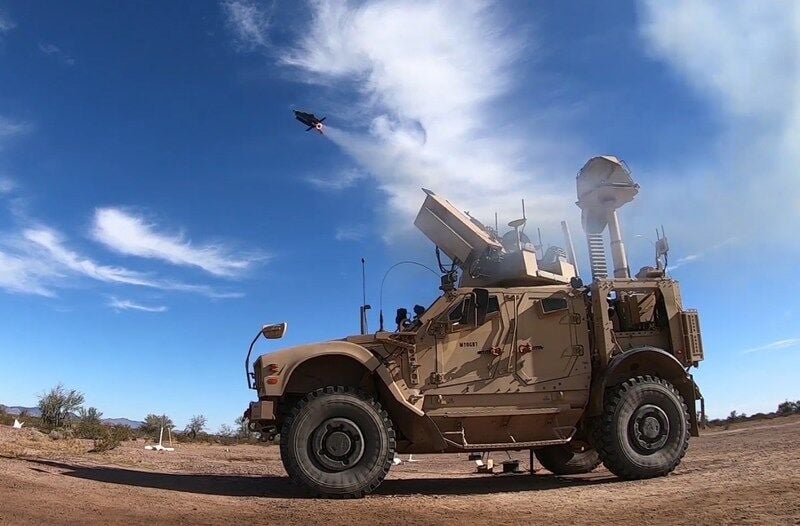Tucson-based Raytheon Missiles & Defense continues to advance the nation’s ability to defend against attacks by unmanned aircraft — with its own, counter-drone drones.
Raytheon’s small Coyote drone, paired with a mobile Raytheon radar system, detected and defeated swarms of target drones of varying size and range in recent testing for the Army, the company announced during a major defense event held Oct. 11 through 13.
During the Association of the U.S. Army annual meeting and exhibition in Washington, D.C., Raytheon said it successfully showcased several Coyote counter-drone capabilities during the Army’s 10-day summer test period in partnership with the U.S. Army’s Integrated Fires and Rapid Capabilities Office.
The Coyote — originally developed by a Tucson tech startup in the 2000s and later acquired by Raytheon — was initially used for things like weather research and reconnaissance.
But Raytheon has created subsequent Coyote versions that can destroy enemy drones by crashing into them or by exploding near them, to help the Army meet an urgent need to defend against drones under development by several adversary nations.
More recently, attention has turned to defending against “swarms” of drones under development by China and others.
The summer tests used Coyote interceptor variants with Raytheon’s KuRFS precision targeting radar and its Ku-720 mobile radar — a scaled-down version of the KuRFS system — to target and defeat the drone swarms while providing an overall, 360-degree radar picture of the battle area.
Some Coyotes are already in the field, even as Raytheon works on more capable versions.
The Coyote-KuRFS system, dubbed the Howler Counter Unmanned Aerial System (C-UAS), was deployed by the Army in 2019, after the service declared defense against drones, rockets, mortars and other airborne threats an “urgent operational need.”
“Together with our Army partners, we showcased the maturity and lethality of our Counter-UAS systems against single and multiple drone threats to both U.S. and international customers,” said Abel Ghanooni, Raytheon senior director for short-range air defense and rapid development programs. “These tests move us closer to deploying Coyote and Ku-720 globally, so they can protect service members and critical assets from enemy drones.”
The Coyote drones can be launched from a common tube launcher by ships, submarines or aircraft, with its wings or control fins popping out upon launch.
Early versions of the Coyote were propeller-driven craft designed for long-duration intelligence, surveillance and reconnaissance, with long fold-out wings. The Coyote 1B version added a radar target seeker and a proximity warhead to destroy targets by exploding nearby.
More recently, Raytheon has developed the Coyote Block 2, which looks and acts more like a subsonic cruise missile, with a jet engine for increased speed and range, and narrow control fins instead of a long main wing and tailfins. The Block 2 also features improved sensors.
Last year, the U.S. government cleared Raytheon to sell the Coyote Block 2 counter-drone weapon to approved allied nations as part of the Howler system.
Raytheon also has developed the reusable Coyote Block 3, which can be outfitted with so-called “non-kinetic effectors” — details of which have not been released but could include things like microwave pulses or jamming to bring down targets without contact.
The Office of Naval Research — which funded much of the early development of the Coyote in the early 2000s — awarded Raytheon a $33 million contract in February to develop the Coyote Block 3 for reconnaissance and a defensive strike capability when launched from unmanned surface or underwater vessels.
In July, Raytheon said that Coyote Block 3s had defeated a swarm of 10 target drones of varying complexity in testing for the Army.
New radar revealed
Also at the Association of the U.S. Army exhibition, Raytheon unveiled a new, medium-range radar for the National Advanced Surface-to-Air Missile System, or NASAMS, an air-defense system in development with Norway’s Kongsberg Defence & Aerospace.
Raytheon said the new “GhostEye MR” radar offers increased range and altitude coverage and expands NASAMS capability to detect, track and identify enemy aircraft, unmanned aircraft systems, and cruise missile threats.
The KuRFS and Ku-720 radars were developed by Raytheon’s former Integrated Defense Systems business unit, which was based in the Boston suburb of Tewksbury but was folded into Raytheon Missiles & Defense as part of the merger with United Technologies that formed Raytheon Technologies Corp. last year.
The integrated defense business is now headquartered in Tucson, while development and production of radars and systems including the Patriot air-defense system continues at facilities in the Boston area, where parent Raytheon Technologies is based in Waltham.
Tucson-based World View Enterprises plans to start flying tourists to the stratosphere in balloon vehicles by 2024. Video courtesy of World View.





